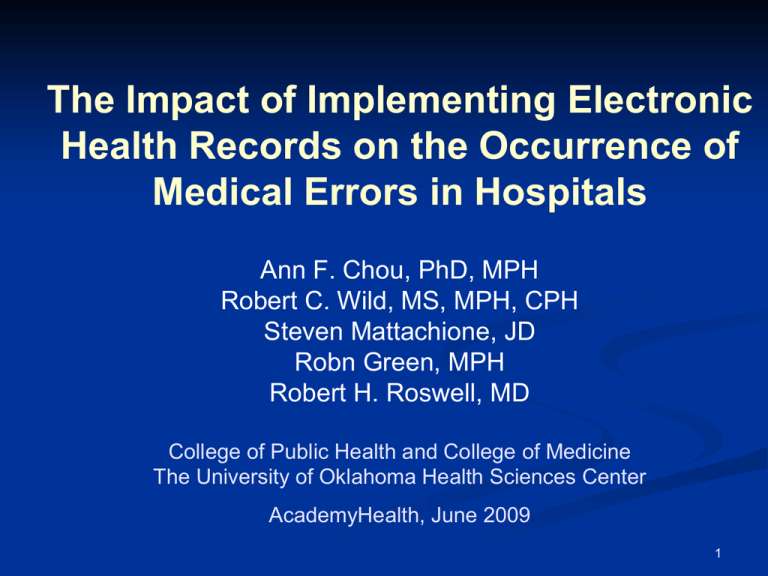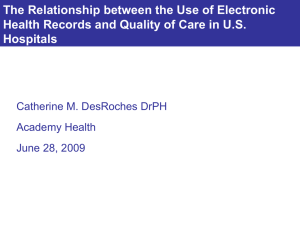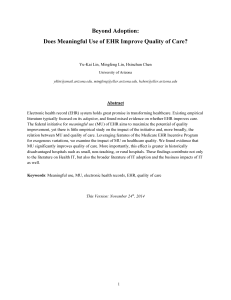The Impact of Implementing Electronic Health Records on the Occurrence of
advertisement

The Impact of Implementing Electronic Health Records on the Occurrence of Medical Errors in Hospitals Ann F. Chou, PhD, MPH Robert C. Wild, MS, MPH, CPH Steven Mattachione, JD Robn Green, MPH Robert H. Roswell, MD College of Public Health and College of Medicine The University of Oklahoma Health Sciences Center AcademyHealth, June 2009 1 Background To Err is Human, Institute of Medicine, 2000 Estimated 44,000-98,000 Americans die each year from preventable medical errors Crossing the Quality Chasm, Institute of Medicine, 2001 Recommended the use of health information technology as a transforming strategy to reduce errors 2 Key Strategies for Improving Quality of Care National voluntary quality campaigns 39 Stronger regulatory oversight of providers 50 Financial incentives for improved quality 51 Public reporting of provider performance 59 67 Accelerating IT adoption 0 10 20 30 40 50 60 70 80 Percent Source: Commonwealth Fund/Modern Healthcare Opinion Leaders Survey, 2007 3 Benefits of Health IT Adoption Patient safety and quality Reduction in medical errors or adverse events Reduction in redundant testing/duplicative services Timely preventive/screening services Promotion of evidence based medicine Inpatient savings Shortened length of stay (LOS) Efficiency savings Outpatient savings Efficiency savings Enhanced billing productivity 4 Current Health IT Implementation In a survey of 2,758 physicians, 13% utilize a basic electronic record system but only 4% are using a fully functional system in their offices.1 In a survey of 3,049 hospitals, 7.6% have a basic system and only 1.5% have a comprehensive electronic health system.2 1 DesRoches CM, Campbell EG, Sowmya R, et al. Electronic health records in ambulatory care-A national survey of physicians. New Engl J Med. 2008; 359:50-60. 2 Jha AK, DesRoches CM, Campbell EG, et al. Use of electronic health records in U.S. hospitals. New Engl J Med. 2009; 360: 1628-38. 5 Objective The goal of this study is to understand the impact of implementing electronic health records (EHR) on the likelihood of an adverse medical event (AME) occurrence. 6 Data 2006 Oklahoma data sources: 156,630 discharges from 50 ambulatory surgical centers 520,829 inpatient hospitalizations from 137 hospitals 283,700 outpatient discharges from 96 hospitals 161 health care facilities in the Oklahoma Annual Cooperative Hospital Survey Patients were linked with facility level information. The final dataset included 529,332 patients from 117 facilities. 7 Measures: Outcome Variables From 2006 ICD-9 Codes: Medical misadventures to patient during surgical and medical care (E870-876) Medication errors (E850-858) Other surgical or procedural errors without mention of misadventure as the cause of abnormal reaction of patient or complications (E878-E879) 8 Measures: Covariates Fully implemented EHR v. Paper-based system or Partially implemented EHR Patient demographics Gender Race/ethnicity Age groups Length of stay in days Weekend admission Comorbidity Hospital characteristics Ownership status Network/Joint venture Bed size 9 Analysis Hierarchical generalized linear modeling (HGLM) estimated with Generalized Estimating Equations (GEE) that allowed for the clustering of observations within hospitals was used to investigate associations between the occurrence of AMEs and EHR implementation, controlling for patient and hospital level characteristics. 10 Descriptive Statistics: Patients Gender Female: 315,918 (59.7%) Male: 213,414 (40.3%) Age Group <1 year: 57,890 (10.9%) 1-19: 36,814 (7.0%) 20-44: 120,013 (22.7%) 45-64: 125,396 (23.7%) 65+: 189,219 (35.8%) Race/Ethnicity White: 431,562 (81.5%) African American: 43,041 (8.1%) Native American: 22,462 (4.2%) Other: 32,267 (6.1%) 11 Descriptive Statistics: Patients Insurance Coverage Commercial: 151,380 (28.6%) Medicare: 207,831 (39.3%) Medicaid: 110,966 (21%) Uninsured: 34,031 (6.4%) Other: 25,124 (4.8%) Co-morbidities None: 42,138 (8%) 1-5: 263,527 (49.8%) 6-10: 169,465 (32%) 11-15: 54,202 (10.2%) Mean Length of Stay 4.42 days 12 Descriptive Statistics: Hospitals Hospital Has Electronic Health Record (EHR) Type of Organization Government: 36 (30.8%) Not for profit: 30 (25.6%) For-profit: 37 (31.6%) Hospital Participates in Fully implemented: 9 (7.7%) Partially implemented: 22 (18.8%) A network: 23 (19.7%) Joint Venture: 25 (21.4%) Mean Bedsize: 119.6 13 Results Variables Odds Ratio (95% Confidence Interval) Misadventure Medication Error Procedural 0.41* (0.20, 0.83) 0.61* (0.45, 0.82) 0.72 (0.34, 1.51) Gender: Female 1.07 (0.91, 1.25) 0.87* (0.80, 0.96) 0.85* (0.81, 0.90) African American 0.64* (0.43, 0.95) 0.99 (0.83, 1.17) 0.97 (0.81, 0.90) Native American 0.95 (0.62, 1.45) 1.09 (0.88, 1.35) 1.02 (0.94, 1.10) 0.99 (0.42, 2.31) 24.4* (12.24, 48.83) 2.44* (1.86, 3.19) 20-44 5.49* (2.04, 14.78) 10.36* (5.38, 19.96) 2.82* (1.78, 4347) 45-64 7.02* (2.62, 18.85) 8.45* (4.92, 14.50) 3.79* (2.28, 6.31) 65+ 4.99* (1.90, 13.05) 3.46* (2.07, 5.79) 3.07* (1.93, 4.90) Fully implemented EHR Patient Demographics Age (<1 year of age) 1-19 * Statistically significant 14 Results Variables Odds Ratio (95% Confidence Interval) Misadventure Medication Error Procedural Weekend Admission 0.52* (0.42, 0.65) 1.65* (1.41, 1.93) 0.77* (0.73, 0.81) Length of stay 1.01* (1.01, 1.02) 0.85* (0.81, 0.88) 1.01* (1.00, 1.02) Number of comorbidities 1.07* (1.05, 1.09) 1.20* (1.17, 1.22) 1.08* (1.06, 1.10) For-Profit 3.21* (1.27, 8.09) 0.59* (0.39, 0.90) 3.29* (1.30, 8.33) Not for profit 1.94* (1.04, 3.64) 0. 93 (0.66, 1.32) 1.77 (0.73, 4.28) 2.10* (1.20, 3.68) 0. 91 (0.64, 1.29) 1.98 (0.92, 4.24) Hospital Ownership (Government) Hospital is joint venture * Statistically significant 15 Discussion Findings showed that AMEs were less likely to occur if an EHR has been fully implemented in comparison to no or partially EHR implementation. Although the capital costs have often been cited as a primary barrier for EHR implementation, the reduction in errors presents a business case of return on investments in support of wider EHR adoption and use. 16 Limitations ICD-9 codes not designed to capture all medical errors Reliance on provider and organization report of medical errors Lack of clinical details in administrative datasets Lack of determination of when the AME occurred during hospitalization 17 Implications A systems approach to prevent AMEs is warranted, with the implementation of clinical information systems serving as a key strategy to reduce these errors. Better patient safety and quality, along with stabilization of rising US health care costs may be dependent upon wider implementation of electronic records systems. Despite the current economic situation, efforts to increase adoption of EHRs will be prominent in the next several years. 18 Acknowledgements Funded by: Agency for Healthcare Research and Quality Oklahoma State Department of Health Binitha Kunnel Kelly Baker 19 THANK YOU Ann F. Chou (405) 271-2115 ext 4 ann-chou@ouhsc.edu 20






